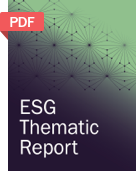Environment, Social and Governance (ESG) in Anti-Aging Products Industry
Sustainability and ESG related risks are beginning to have significant impacts on a business alongside other financial and non-financial risks in many industries. One such industry is the anti-aging Products industry. The market of beauty products is expanding exponentially resulting a boost in consumerism globally. Out of plethora of beauty products, anti-aging products have become conspicuous in the shelves of supermarkets. But to advance rapidly towards the United Nations’ Sustainable Development Goals (UN-SDGs), it becomes essential to delve into this market through the lens of ESG.
The feel-good factor introduced by these products marketing teams have blinded the customers from behind the curtain facts of this industry. Marketing around beauty inclusivity and sustainably produced personal care products have gained attention in the market. But the reality is a little twisted which indicates material ESG Risks in the background. Narrowing it down to anti-aging products, it can be said that these products are trying to rectify pollution-related damage to the skin by contributing more to exploitation of resources, irresponsible disposal and recycling which is a direct threat to more than one SDG. Directly affected SDGs due to this market are - Responsible Consumption and Production (SDG12), Climate Action (SDG 13), Life Below Water (SDG 14), Life on Land (SDG 15). Therefore it becomes important to trickle down sustainability to all the levels of stakeholders of this industry.
Adversities necessitating ESG in Anti-aging products industry
As anti-aging products hold a great share of cosmetics industry, it becomes necessary to look at the supply chains of these products. Consumer awareness about age-related concerns have resulted in increased demand for anti-aging cosmetics product fueling modern-day slavery as many products used in this industry are procured by smallholder farmers. Therefore, cosmetics supply chains often lack oversight and ultimately encourage issues like child labor. This factor stands face-to-face with the SDG Goal 12 of Responsible Consumption and Production.
Palm kernel oil is one of the commonly used ingredients in anti-aging products. Palm oil contains vitamin-E and helps in fighting the reasons for wrinkles and fine lines. Palm oil production has complex effects on environment and humankind simultaneously therefore increasing dependency on palm oil is resulting into massive effects on human life and the environment. Due to the profitability of this oil over other oils, more and more farmers are shifting to farming of Palm Kernels. This is resulting in deforestation, soil degradation and habitat loss for humans and animals (SDG 13). For final use of palm oil, these kernels go through mills for giving out oil. Palm oil mill generates 2.5 metric tons of effluent for every metric ton of palm oil. Direct and irresponsible release of these effluents can cause freshwater pollution ultimately affecting the under-water biodiversity (SDG 14).
Last but not the least, major packaging material used for these products comprise of different kinds of plastics that sit in the dumping grounds, soil, and water for years.
ESG Trends
With 76% of consumers seeking sustainable beauty products, anti-aging products market has also come under the scrutiny. The environmentally aware consumer base has helped companies to shift to eco-friendly packaging. One of the biggest examples is set by Credo by requiring all the 130+ brands to follow Sustainable Packaging Guidelines for all 130+ brands to meet specific standards targeted to reduce the single use plastics, virgin plastics, and non-recyclable materials.
Demand for sustainable products have also encouraged new names like Forest Essentials and Mama Earth in the market. These brands have a range of anti-aging products that are being used by the consumer guilt-free. The fact that natural skin care products are expected to expand at a compound annual growth rate (CAGR) of 6.6% from 2022 to 2030 will prove to be a driver for increase in natural anti-aging products too.
Producers have also shifted to the alternatives for Palm Oil and other animal oils. These oils are replaced by renewable vegetable oils and fats.
ESG Challenges
With increasing inclination towards anti-aging products, this sector has a huge consumer base. The extent of consumerism makes it difficult to manage the resources that go in the making of these products as well as the waste that is dumped.
Secondly, it will be difficult for this vast industry to find environment-friendly alternatives for ingredients such as palm oil, shea butter for mass production.
Growth of the Anti-Aging Products Market
The global anti-aging products market size was valued at USD 40.49 billion in 2020 and is expected to expand at a compound annual growth rate (CAGR) of 5.4% from 2021 to 2028. On the other hand, Indian Anti-Aging Market is predicted to grow at a CAGR of 12% from 2022-2027. Hence, anti-aging products have a big consumer base globally and it will be an arduous task to bring uniform sustainability in this sector.
Key Companies in this theme
• Estee Lauder Inc.
• Procter & Gamble
• Beiersdorf Ltd.
• Unilever
• L’Oreal
Scope of Anti-Aging Products Industry ESG Thematic Report:
• Macro-economic and ESG-variable analysis of the industry, including regulatory, policy, and innovation landscape
• Key insights on infrastructure developments and ESG issues affecting the theme
• Identify key initiatives and challenges within the industry
• Identify ESG leaders within the industry
• Understand key initiatives and the impact of companies within the sector to fuel an informed decision-making process
• Analysis of industry activities based on multi-media sources, including significant controversies and market sentiment
Key Benefits of Anti-Aging Products Industry ESG Thematic Report:
• Developing a comprehensive understanding of macro-economic, Policies & Regulations and innovations affecting the Life science analytics Sector, globally
• Key insights into environmental developments and ESG issues affecting the theme
• Identifying ESG risks and opportunities to business among leading players in the market
• Obtaining a clear and relevant understanding of company actions, progress, and impact and find opportunities for investment into the sector


